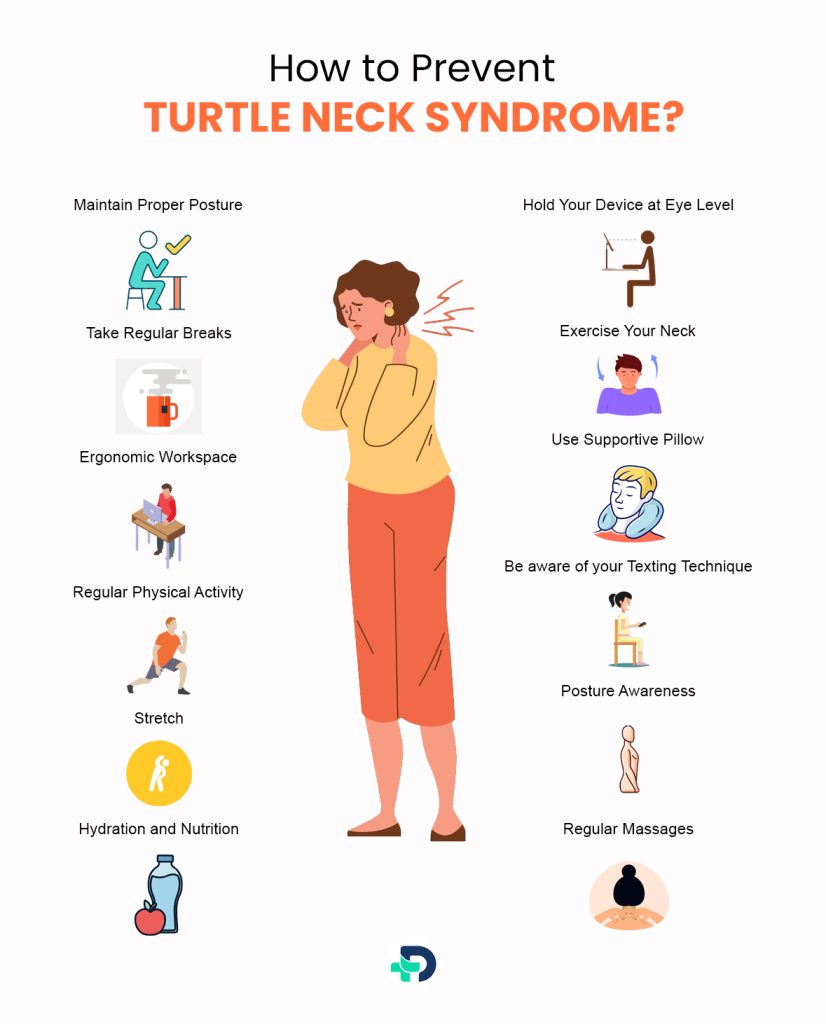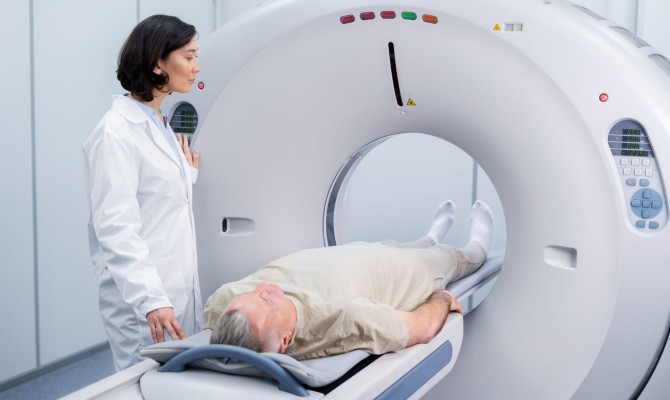Turtle Neck Syndrome: Symptoms, Causes, Prevention & Treatment

- Neck Pain
- 28 Sep 2023
Introduction
Turtle Neck Syndrome
A strange health condition known as Turtle Neck Syndrome appears as a quirky but significant problem in the enchanted world of technology, where displays and computers cast their captivating spells.

Imagine a world where people unknowingly transform into gentle turtles, their heads slowly retraction into their shoulders due to their fascination with their screens. The amusing phrase “Turtle Neck Syndrome” was coined as a result of this odd posture, which is reminiscent of the graceful reptile.
Please don’t flex your neck while reading this and keep your phone at eye level; your neck and shoulders will thank me later.
The syndrome depicts people as being lured into the digital world, their heads lowered to the glittering screens, and their necks curling in a turtle-like manner. However, the humorous picture masks a sobering warning about the negative impacts of excessive screen time.
The syndrome invites us to consider how crucial it is to keep a positive relationship with our technology while also protecting our physical health.
Causes
What Causes Turtle Neck Syndrome?
Text neck 1 Causes | Researched based study from National Institutes of Health, often referred to as turtle neck syndrome, is a disorder brought on by incorrect and continuous usage of electronic devices like smartphones and tablets.
It may cause a variety of aches and pains in the upper back, shoulders, and neck.
The following are some typical reasons for turtle neck syndrome:
Device Usage Posture:
- Holding a device at an uncomfortable angle and frequently looking down for prolonged periods of time aggravates neck and upper back muscles and ligaments.
Repetitive Movements:
- Constantly lowering your head while texting or browsing might put undue stress on your neck muscles, making you feel stiff and uncomfortable.
Muscle Fatigue:
- Constant use of a device wears out the muscles that support it, causing weakness and a sense of weightiness in the shoulders and neck.
Lack of Breaks:
- Constant use of electronics without pauses hinders the muscles from relaxing, increasing the likelihood of strain.
Poor Ergonomics:
- Bad workplace ergonomics, such as having a computer screen that is too high, can lead to bad neck position.
Weak Core Muscles:
- Your neck and shoulders will have to work harder to maintain equilibrium if you lean forward due to a weak core.
Tension and Stress :
- Unintentional neck muscular tension brought on by emotional stress can exacerbate discomfort and agony.
Impact on Spine:
- Consistent bad posture can change the way your spine is aligned, which can cause problems beyond only neck pain in the long run.
Decreased Blood Flow:
- A bad posture can narrow blood vessels, decreasing blood supply to the muscles and resulting in pain.
Symptoms
How do You Know if You Have Turtle Neck Syndrome?
The turtle neck syndrome, often referred to as text neck or tech neck, develops when people repeatedly incline their necks downward to gaze at their cellphones, tablets, or computers.
Numerous problems may result from this posture, which can strain the muscles in the neck and upper back.
See if you notice any of the following issues persisting after device use. Prevent it by putting screens at eye level, taking frequent pauses, and stretching your neck. Seek medical attention if the condition persists.
Neck pain:
- It is the most typical sign of turtle neck syndrome 1 Symptoms| Researched based study from National Institutes of Health.
- People may experience pain, stiffness, or discomfort in their neck area.
- Additionally, the shoulders and upper back may experience soreness.
- Long-term forward head posture can increase strain on the spine and cause muscle imbalances, headaches, and even migraines.
- Additionally, the neck and upper back muscles may ache and become weak in those who have this disease.
- Over time, it may become difficult to maintain a straight posture due to this. The continual stress on these muscles may cause a decrease in neck flexibility and range of motion.
Tingling and Numbness:
- The tingling or numbness in the hands and arms is another sign.
- Long-term bad posture can compress neck nerves, resulting in pins-and-needles symptoms or even weakness in the extremities.
Bad posture:
- People may detect changes in their posture, such as rounded shoulders and an upward curvature in the upper back.
- This might be uncomfortable and have an effect on how the body is positioned overall.
- The best way to avoid turtle neck syndrome when using devices is to be aware of your posture.
- Taking frequent pauses, working on strengthening your neck and upper back muscles, and making sure your devices are at eye level will all assist with discomfort.
In general, the symptoms of turtle neck syndrome include neck stiffness, aching muscles, tingling, changes in posture, and discomfort brought on by continuous use of electronic devices with a slouched downward head position. These symptoms can be avoided and managed by being mindful of your posture and taking steps to keep your head in a neutral position.
Muscle relaxants for Turtle Neck Syndrome:
- Magnesium supplements may be beneficial by encouraging muscle relaxation and easing tension in the muscles.
- Magnesium helps with muscle contraction, nerve conduction, and general relaxation.
- The effects of supplements can be enhanced by including ergonomic measures, stretching exercises, and minimizing device use.
- Before ingesting any supplements, you must speak with a doctor, especially if you have a medical condition or are taking medication.
Types
Types of Turtle Neck Syndrome
Turtle neck syndrome is a term used to describe a number of disorders that result from bad posture or prolonged gadget use and cause pain and discomfort in the neck and shoulder region.
There are several common forms, including
- Text Neck, which results from gazing down at devices, Tech Neck, which is brought on by prolonged computer use.
- Forward Head Posture,which is characterised by a protruding head and rounded shoulders.
- These syndromes frequently result in spine misalignment, muscle strain, and headaches.
- These problems can be avoided and treated by maintaining good posture, taking pauses, and doing neck exercises.
Diagnosis
How is Text Neck Syndrome Diagnosed?
- Pay attention to signs like stiffness in the neck and discomfort when diagnosing 2 Diagnosis | Researched based study from National Institutes of Health it.
- Seek medical advice if you suffer these problems.
- They’ll probably enquire about your medical history, gadget using patterns, and physical condition.
- The doctor will examine your neck’s range of motion, muscle strength, and any sensitive spots during the examination.
- They could also inquire about the nature and timing of the discomfort.
- To rule out additional potential reasons, imaging procedures like X-rays or others may be utilized.
- Tell the truth about your usage of electronic devices and any pain you feel to assist the doctor diagnose turtle neck syndrome.
- If a diagnosis is made, the doctor could advise making lifestyle adjustments including improving posture, taking breaks from technology, and performing neck exercises.
- If discomfort doesn’t go away, other treatments like physical therapy or painkillers could be suggested.
- Turtle neck syndrome can be prevented and treated in large part by early detection and adjustments in device usage patterns.
Implications
Health Implications of Turtle Neck Syndrome
- The primary concern with Turtle Neck Syndrome is that it can result in a number of different health issues. Neck stiffness and pain are among the main issues.
- Long periods of time with your head bowed forward can put stress on your neck muscles, resulting in pain and discomfort. As the pain from the tense neck muscles can go to the brain, this may also contribute to headaches.
Unhealthy Posture:
- It is another implication. A forward-leaning head position and rounded shoulders might result from constantly hunching over screens.
- Your spine’s position may be impacted with time, which may result in postural issues.
- Without making a conscious effort, standing up straight could become more difficult, which can lead to long-term musculoskeletal problems.
Flexibility:
- The flexibility of your neck can also be impacted by turtle neck syndrome.
- Long-term eye contact with displays can tighten the neck’s muscles and ligaments, making it difficult to swivel or tilt your head comfortably.
- There may be discomfort as a result of this restricted range of motion.
To sum up, Turtle Neck Syndrome serves as a reminder of the value of a balanced, ergonomic approach to using technological gadgets. We can assist reduce the pain and health problems linked to prolonged screen use by making simple behavioural changes.
Can Children Develop Turtle Neck Syndrome?
Children and adults alike may experience text neck, commonly referred to as turtle neck syndrome.
- When children spend a lot of time staring down at devices with displays, such as phones, tablets, or computers, it occurs.
- The neck muscles and spine are strained in this position, which hurts and is uncomfortable. Children may experience stiffness, headaches, or aches.
- Encourage kids to hold their gadgets at eye level, take pauses, and perform neck exercises to avoid this.
- It’s like telling them to sit up straight to maintain the health of their neck and back.
- So, yes, Turtle Neck Syndrome can occur in youngsters, but it is preventable by taking a few easy precautions.
Prevention

How to Prevent Turtle Neck Syndrome?
- Turtle neck syndrome, commonly referred to as text neck, is a disorder that develops from using smartphones or tablets for extended periods of time and results in bad posture, which strains the muscles in the neck and upper back.
- Fortunately, there are a number of easy precautions 1 Prevention | Researched based study from National Institutes of Health you may take to prevent or lessen this syndrome:
Maintain Proper Posture
- Try to maintain a straight back and a spine-aligned position when using electronic gadgets.
- Avoid gazing down or hunching forward for too long.
Hold Your Device at Eye Level
- This will prevent you from bending your neck to look at the screen.
- Your neck muscles may feel less strain as a result of this.
Take Regular Breaks
- Set a timer to prompt you to stop working every 20 to 30 minutes.
- Stretch your neck, shoulders, and back during these breaks to release stress.
Exercise Your Neck
- To keep your neck flexible, gently stretch and rotate it.
- To relax, slowly move your head up and down and side to side.
Ergonomic Workspace
- If you sit at a desk to work, make sure your computer monitor is at eye level and that your chair supports your lower back.
- This might encourage more upright posture.
Use Supportive Pillow
- When you’re sleeping, pick a pillow that supports the natural curvature of your neck.
- This lessens strain when you’re sleeping.
Regular Physical Activity
- Exercise frequently to build up the muscles in your neck, back, and core.
- Your entire posture can be improved, and the chance of strain is decreased.
Be aware of your Texting Technique
- Use both hands to hold your phone while using your thumbs to type.
- By doing this, the tension from holding the tablet with one hand while typing with one finger is lessened.
Stretch
- Incorporate basic neck and shoulder stretches into your everyday regimen.
- Your muscles will remain relaxed and flexible as a result.
Posture Awareness
- Maintain good posture throughout the day.
- When you catch yourself slouching or bending your neck too much, correct yourself.
Use Voice Commands
- When using voice commands to operate your device, do so whenever practical.
- This can lessen the need to type or look down for extended periods of time.
Binge Laptop User
- If you use a laptop, you might want to think about using an external keyboard and mouse.
- Use a stand or books to raise the laptop’s screen so that it is at eye level.
Hydration and Nutrition
- Keeping hydrated and eating a healthy diet can help to preserve the health of your muscles and lower your chances of developing muscle strain.
Regular Massages
- Periodic massages of the neck and shoulders can help reduce stress and enhance blood flow to the troubled areas.
Limit Device Usage
- Cut down on the amount of time you spend using electronic devices, particularly ones that require prolonged neck flexion.
Keep in mind that preventing turtle neck syndrome requires making minor changes to your routine and environment. By putting the above mentioned strategies into practice, you may lessen the stress on the muscles in your neck and upper back, improving your posture all around and lowering your risk of discomfort and suffering.
Consider seeking personalised guidance from a healthcare professional if you have ongoing pain or discomfort.
Lifestyle Changes
Lifestyle Changes for Turtle Neck Syndrome
- More time is spent using electronic gadgets, which increases the amount of time spent in uncomfortable neck and back postures. If you want to avoid turtle neck syndrome, think about developing healthier gadget habits.
- It’s crucial to adopt healthy device habits to prevent these health effects. When utilising screens, keep in mind that you should constantly switch positions and take pauses.
- To keep your neck flexible and strengthen the supporting muscles, perform neck stretches and exercises.
- Additionally, pay attention to your posture while standing or while sitting to keep your spine straight.
- Holding devices at eye level, taking frequent pauses, stretching the neck and shoulders, and maintaining good posture are all recommended.
- Exercises that strengthen the neck, shoulders, and core can also lower the likelihood of having this illness.
- For advice and treatment options if you encounter ongoing pain or discomfort, speak with a healthcare practitioner.
Complications
What are the Short & Long Term Complications of Turtle Neck Syndrome?
Several immediate problems can result from turtle neck syndrome:
- The neck and shoulder region may experience discomfort and suffering as a result of the tension on the neck muscles and the spine’s position.
- From mild to severe, this pain may interfere with regular activities.
Imbalances in the muscles
- Due to the awkward posture, the muscles in the neck, shoulders, and upper back may become unbalanced.
- There may be discomfort and limited movement as a result of some muscles becoming too tense and others becoming weak.
Headaches
- Tension headaches can result from the forward head position’s impact on the muscles and nerves at the base of the skull.
Reduction in Lung Capacity
- Slumping down can restrict lung expansion by compressing the chest.
- This could result in lower oxygen intake and shallow breathing, which could wear one out and sap their vitality.
Poor Digestion
- A hunched posture can compress the abdomen, which affects digestion.
- This could result in problems like indigestion and post-meal pain.
Nerve Compression
- The spine’s misalignment can exert pressure on the nerves in the neck and upper back, causing tingling, numbness, or even pain that radiates down the arms.
Deteriorated Blood Circulation
- Blood flow may be impacted by bending forward, which could result in decreased circulation in the neck and head region.
- This could result in chilly or numb sensations.
Low Confidence
- Your presentation may suffer if you have poor posture.
- In both social and business contexts, slouching may give the impression that you lack engagement and confidence.
- It’s crucial to pay attention to your posture if you want to avoid these problems.
- Your posture can be improved and your chance of experiencing issues connected to Turtle Neck Syndrome can be decreased by taking regular breaks to stretch, doing back and core muscle strengthening exercises, and setting up an ergonomic workspace.
- It’s wise to get advice and help from a healthcare provider if discomfort doesn’t go away.
Role of Ergonomic pillows in Turtle Neck Syndrome:
- Think of your neck as a tower holding up your head.
- That tower may start to sway if you are too deep in your technological world, which results in a tech neck. Pillows with good ergonomics are like tower architects.
- They create pillows that support your head and neck while you navigate and swipe, keeping you comfortable and upright.
- No more neck-leaning towers! These pillows act as superhero capes, protecting your neck from the villainous tech neck villain.
- So yes, ergonomic pillows may ensure you live a comfortable and healthy life without tech neck while using technology!
This condition may lead to several long-term consequences, including:
Degenerative Changes
- Such as herniated discs, spinal arthritis, and spinal misalignment, can be accelerated by ongoing stress on the spine 2 Complications | Researched based study from National Institutes of Health.
Continual Pain
- Chronic discomfort in the neck, shoulder, and upper back may result from tension on muscles, ligaments, and discs.
Functionality
- It may be compromised as a result of these issues over time, which may have an effect on everyday activities and quality of life.
Maintaining proper posture,taking pauses, and engaging in back and neck strengthening activities are all part of prevention. To avoid further complications, it is critical to seek medical care if symptoms continue.
Can Stress Aggravate Turtle Neck Syndrome?
- Stress can exacerbate Turtle Neck Syndrome because it causes us to unconsciously hunch our shoulders and tilt our heads forward.
- This puts further strain on our upper back and neck muscles, which are already weak from bad posture.
- Imagine that your body tenses up and your muscles could tighten when you are under stress.
- Your neck muscles have to work harder to hold your head in that forward position if you’re also slouching over a computer or staring down at your phone.
- This may result in pain, tightness, and strain over time.
Therefore, Turtle Neck Syndrome is more likely to get worse if you’re stressed out and careless with your posture.
Treatment
Treatment for Turtle Neck Syndrome
If you’re experiencing persistent discomfort or pain related to tech neck, it’s important to consult a medical professional for proper evaluation and treatment recommendations. Here are some medical treatment options that a healthcare provider might suggest:
Physical Therapy:
- A physical therapist can assess your posture, muscle imbalances, and movement patterns.
- They can provide exercises and stretches targeted at improving your neck and upper back muscles, as well as offer guidance on proper ergonomics and body mechanics.
Pain Medication:
- Over-the-counter pain relievers may help manage pain and inflammation.
- However, these should only be used as directed by a healthcare professional.
Muscle Relaxants:
- If muscle tension is a significant issue, a doctor might prescribe muscle relaxant medications to help alleviate muscle spasms.
Heat or Cold Therapy:
- Applying heat or cold packs to the affected area can help reduce muscle tension and provide relief.
- A healthcare provider can advise on the appropriate use of these therapies.
Injections:
- In some cases, corticosteroid injections may be recommended to reduce inflammation and provide temporary relief from pain.
Posture Correction:
- A healthcare provider can guide you on proper posture techniques, exercises, and habits to prevent further strain on your neck and upper back.
Bracing or Support:
- If severe muscle tension or postural issues are present, your doctor might suggest using a neck brace or other supportive devices to assist with maintaining proper alignment.
X-rays or Imaging:
- In certain cases, your healthcare provider might order imaging tests like X-rays to assess the alignment of your spine and identify any underlying structural issues.
Customized Treatment Plan:
- Based on your individual condition, medical history, and symptoms, your healthcare provider will create a personalized treatment plan that may combine several approaches to provide the best outcome.
Remember, seeking professional medical advice is crucial for accurate diagnosis and appropriate treatment.
Surgery
Surgery as an Option for Turtle Neck Syndrome
- Surgery is typically not the first-line treatment for tech neck or neck discomfort caused by poor posture.
- Most cases of tech neck can be managed effectively through conservative measures such as posture correction, physical therapy, exercises, and lifestyle adjustments.
- Surgery is usually considered only when conservative treatments have been exhausted, and there is a significant structural issue or underlying medical condition that requires surgical intervention.
- If you are experiencing severe and persistent symptoms that cannot be relieved by non-surgical methods, it’s essential to consult with a medical professional, such as an orthopedic surgeon or a spine specialist.
- They will evaluate your condition, medical history, imaging results, and overall health to determine whether surgery is a suitable option.
- If surgery is recommended, the specific procedure would depend on the underlying issue and the extent of the problem.
- Some surgical options that might be considered in cases of severe neck problems include:
Cervical Fusion:
- This procedure involves the fusion of two or more cervical vertebrae using bone grafts and possibly hardware such as plates and screws.
- It’s typically used to treat conditions like herniated discs, degenerative disc disease, or instability in the neck.
Cervical Artificial Disc Replacement:
- Instead of fusing vertebrae together, an artificial disc is inserted to replace a damaged or degenerated disc.
- This aims to maintain motion and flexibility in the neck while addressing the underlying problem.
Foraminotomy:
- This procedure involves enlarging the spaces through which nerve roots exit the spinal canal, relieving pressure on nerves that might be causing pain or discomfort.
Laminectomy:
- In cases of spinal stenosis (narrowing of the spinal canal), a laminectomy might be performed to remove part of the vertebra (lamina) to create more space and relieve pressure on the spinal cord or nerves.
Minimally Invasive Surgery:
- Some surgeries can be performed using minimally invasive techniques, which involve smaller incisions and reduced tissue damage.
- These approaches can lead to quicker recovery times compared to traditional open surgeries.
- It’s important to note that surgery comes with risks, including infection, bleeding, nerve damage, and complications from anesthesia.
- Additionally, recovery from spinal surgery can be a lengthy process and may require physical therapy and rehabilitation.
- Always consult with a qualified medical professional to thoroughly discuss your options, understand the potential benefits and risks, and make an informed decision based on your individual circumstances.
Complications of Surgery:
A discectomy is a procedure to remove all or part of a damaged spinal disc; it is frequently carried out to treat discomfort from a bulging disc. Although typically secure, there may be issues:
Infection:
- There is a slight possibility of infection at the surgical site following surgery, which may require antibiotics.
Nerve Damage:
- During surgery, the nerves close to the disc may be damaged, leading to weakness, numbness, or pain.
Recurrent Disc Herniation:
- The disc may occasionally herniate once more, necessitating additional care.
Spinal Fluid Leak:
- The spinal fluid that surrounds the spinal cord may leak, leading to infections or headaches.
- Prolonged immobility during the healing process can result in blood clots that could travel to the lungs or brain.
Anesthetic complications:
- Although they are uncommon, anesthetic reactions can happen.
Scar Tissue Development:
- Scar tissue may develop around the surgical site, pressing on nearby nerves and resulting in pain.
Back surgery failure syndrome:
- On occasion, the operation may fail to relieve the pain, leaving the patient with on-going discomfort.
- Occasionally, nerve injury might impair the ability to control one’s bowels or bladder commonly in lumbar spine procedures.
Allergic Reactions:
- Some persons may experience allergic reactions to dressings, medicines, or surgical supplies.
Despite the possibility, these problems are not guaranteed. Your doctor will go over the benefits and drawbacks of the surgery based on your unique set of circumstances.
Exercise
Physiotherapy and Exercises for Turtle Neck
- Here are some simple stretches 3 Exercises | Researched based study from National Institutes of Health and additional strategies for preventing and treating tech neck.
- Stretching shouldn’t hurt when you do it.
- Visit your doctor if you’re doing a neck or posture stretch and your symptoms get worse or you experience new pain.
Exercises used in physical therapy can be extremely helpful in reducing the signs and symptoms and enhancing neck alignment. The following exercises can be helpful:
Chin Tucks:
- Straighten up while seated or standing.
- Gently make a double chin by tucking your chin in toward your neck.
- Hold for a short while, then repeatedly repeat.
- Better head posture is encouraged by this exercise, which helps to strengthen the muscles at the front of your neck.
Neck Stretches:
- Tilt your head slowly to one side, bringing your ear near your shoulder.
- For 15 to 20 seconds, maintain the stretch.
- On the opposite side, repeat.
- This stretch eases stress by concentrating on the side neck muscles.
Shoulder Blade Squeeze:
- While standing or sitting upright and your arms at your sides.
- Try to hold a pencil between your shoulder blades by tightly squeezing them together.
- Hold for a short while, then breathe.
- This exercise strengthens the muscles between your shoulder blades and helps you stand more upright.
To Extend the Upper Trapezius
- Gently tilt your head to one side.
- Then, using the same side’s hand, gently press down on your head to lengthen the stretch.
- After holding for 15 to 20 seconds, switch to the other side.
- The upper trapezius muscles, which are frequently tightened by prolonged gadget use, are the focus of this stretch.
Scapular Retraction:
- Keep your arms at your sides as you sit or stand upright.
- Pulling your shoulder blades toward your spine, slowly retract them.
- Hold for a short while, then breathe.
- The forward-slumping posture linked to the tech neck can be prevented with this exercise.
Thoracic Extension:
- Lean forward in a chair.
- You should gaze up, interlace your fingers behind your head, and slightly arch your upper back.
- This exercise encourages upper back flexibility and works to correct the forward head position.
Stretch Posterior Shoulders:
- Cross one arm across your chest at shoulder height.
- To gently bring the arm closer to your chest, use the other hand.
- Hold for 15 to 20 seconds, then alternate sides.
- The muscles in the back of the shoulders that can tighten up with repeated gadget use are the focus of this stretch.
When completing these workouts, keep in mind that consistency is essential.
As your strength and flexibility improves, gradually up the number of repetitions you do at first.
Before doing these exercises, it’s advised to speak with a physiotherapist or other healthcare provider if you’re in a lot of pain or suffering. Text neck syndrome can also be avoided by taking regular breaks and keeping an ergonomic arrangement for your gadgets.
Is Turtle Neck a permanent condition?
- Consider your neck to be a tree. It’s like overly bending a tree’s stem when you spend a lot of time looking down at devices with screens, such phones or tablets.
- This may result in pain, such as a stiff neck.
- But if you start holding your devices at eye level and take breaks to gaze up, your neck will start to feel better, just like a tree may grow straight if you straighten it with a stick or a rod.
- In order to maintain your neck happy and healthy, it’s crucial to take care of it even though text neck won’t last forever.
Sleeping position to prevent Text Neck
- The ideal sleeping position to avoid text neck is on your back with a good pillow for your neck.
- Your neck and head are in alignment with your spine when you sleep on your back, which eases pressure.
- Pick a pillow that maintains your head in a neutral position and supports the natural curve of your neck.
- Sleeping on your stomach might cause your neck to twist, so avoid doing so.
- Use a firm cushion to keep your head in alignment with your spine if you want to sleep on your side.
- When using electronic gadgets during the day, keep appropriate posture in mind as this can also help prevent text neck.
Pain due to poor posture:
- Having poor posture can result in a number of health issues.4 Poor Posture | Researched based study from National Institutes of Health
- Our muscles, ligaments, and joints may become more stressed when we sit, stand, or move incorrectly.
- Pain and discomfort may come from this, particularly in the neck, shoulders, back, and hips.
- These strains have the potential to develop long-term problems.
- Muscle imbalances brought on by poor posture might cause certain muscles to work too hard while weakening others.
- This can have an impact on our body’s stability and result in issues like chronic pain, headaches, and even breathing and digestive issues.
Bad posture and spinal issues:
- Additionally, bad posture might affect how our spine is aligned.
- Our spinal cord, which is essential for sending information from the brain to the rest of the body, is protected by the spine.
- These impulses can be interfered with by improper spinal alignment, which could result in nerve issues and reduced mobility.
- In essence, having proper posture is crucial to our health as a whole. It lessens the likelihood of joint disorders, nerve-related problems, and muscular pain.
- Our posture can be significantly improved by adopting simple habits like sitting up straight, altering computer setups, and regularly engaging in stretches and exercises. certain actions can assist to prevent certain health issues.
Summary
Turtle Neck Syndrome – Awareness & Workouts are Essential
- A contemporary illness brought on by our fixation with smartphones is turtle neck syndrome, which should not be mistaken with clothing choices. As we slouch over screens, picture your head as a turtle retracting into its shell.
- This syndrome leaves us with discomfort, stiffness, and a turtleneck-like posture. Our addiction to technology damages our spines, which were designed like architectural marvels.
- However, don’t worry workouts and device use with awareness can straighten our spines and save us the destiny of the turtle.
- So let’s elevate our heads, and not just to take selfies, to escape the turtle’s grasp. Since humans are striving for the sky one vertebra at a time, we are not turtles.
Any feedback on this article?
 This Articles content was accurate
This Articles content was accurate Very Informative Article
Very Informative Article I have a question or a comment
I have a question or a comment
 This article contains inaccurate content
This article contains inaccurate content This article was not helpful
This article was not helpful I have a question or a comment
I have a question or a comment
We appreciate your helpful feedback!
Checkout our social pages
References
-
National Institutes of Health
Causes | Symptoms | Prevention
-
National Institutes of Health
Diagnosis | Complications
-
National Institutes of Health
Exercises
-
National Institutes of Health
Poor Posture




































